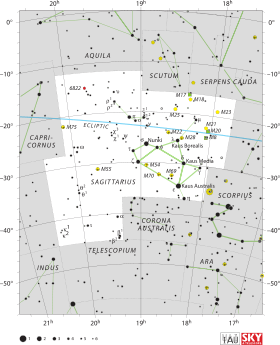Omega Sagittarii
 | |
| Observation data Epoch J2000.0 Equinox J2000.0 (ICRS) | |
|---|---|
| Constellation | Sagittarius |
| Right ascension | 19h 55m 50.3577s[1] |
| Declination | −26° 17′ 58.223″[1] |
| Apparent magnitude (V) | 4.70[1] |
| Characteristics | |
| Spectral type | G5IV[1] |
| U−B color index | +0.32[2] |
| B−V color index | +0.75[2] |
| R−I color index | +0.37[2] |
| Astrometry | |
| Radial velocity (Rv) | −21.0 ± 0.9[1] km/s |
| Proper motion (μ) | RA: 203.96[1] mas/yr Dec.: 74.40[1] mas/yr |
| Parallax (π) | 42.03 ± 0.94[1] mas |
| Distance | 78 ± 2 ly (23.8 ± 0.5 pc) |
| Absolute magnitude (MV) | 2.64[3] |
| Details | |
| Radius | 1.1[4] R☉ |
| Temperature | 5400[5] K |
| Metallicity [Fe/H] | 0.00[5] dex |
| Rotational velocity (v sin i) | 2[5] km/s |
| Age | 2.9 (2.8 to 3.0)[5] Gyr |
| Other designations | |
| Database references | |
| SIMBAD | data |
Omega Sagittarii (ω Sagittarii, abbreviated Ome Sgr, ω Sgr), also named Terebellum,[6] is a G-type subgiant star in the constellation of Sagittarius.[1] It has an apparent visual magnitude of approximately 4.70.
Nomenclature
ω Sagittarii (Latinised to Omega Sagittarii) is the star's Bayer designation.
This star, together with 60, 62 and 59 Sagittarii, formed the asterism called Terebellum.[7] According to a 1971 NASA memorandum, Terebellum was originally the title for four stars: Omega Sagittarii as Terebellum I, 59 Sagittarii as Terebellum II, 60 Sagittarii as Terebellum III and 62 Sagittarii as Terebellum IV .[8] In 2016, the IAU organized a Working Group on Star Names (WGSN)[9] to catalog and standardize proper names for stars. The WGSN approved the name Terebellum for Omega Sagittarii on 5 September 2017 and it is now so included in the List of IAU-approved Star Names.[6]
In Chinese, 狗國 (Gǒu Guó), meaning Dog Territory, refers to an asterism consisting of Omega Sagittarii, 60 Sagittarii, 62 Sagittarii and 59 Sagittarii. Consequently, Omega Sagittarii itself is known as 狗國一 (Gǒu Guó yī, English: the First Star of Dog Territory.)[10]
References
- 1 2 3 4 5 6 7 8 9 10 LTT 7872 -- High proper-motion Star, database entry, SIMBAD. Accessed on line November 19, 2009.
- 1 2 3 HR 7597, database entry, The Bright Star Catalogue, 5th Revised Ed. (Preliminary Version), D. Hoffleit and W. H. Warren, Jr., CDS ID V/50. Accessed on line November 19, 2009.
- ↑ Anderson, E.; Francis, Ch. (2012), "XHIP: An extended hipparcos compilation", Astronomy Letters, 38 (5): 331, arXiv:1108.4971 [astro-ph.GA], Bibcode:2012AstL...38..331A, doi:10.1134/S1063773712050015. Cite uses deprecated parameter
|class=(help) - ↑ HD 188376, database entry, Catalog of Apparent Diameters and Absolute Radii of Stars (CADARS), 3rd edition, L. E. Pasinetti-Fracassini, L. Pastori, S. Covino, and A. Pozzi, CDS ID II/224. Accessed on line November 19, 2009.
- 1 2 3 4 HD 188376, database entry, The Geneva-Copenhagen Survey of Solar neighbourhood, J. Holmberg et al., 2007, CDS ID V/117A. Accessed on line November 19, 2009.
- 1 2 "Naming Stars". IAU.org. Retrieved 16 December 2017.
- ↑ Allen, R. H. (1963). Star Names: Their Lore and Meaning (Reprint ed.). New York: Dover Publications Inc. p. 355. ISBN 0-486-21079-0. Retrieved 2012-09-04.
- ↑ Jack W. Rhoads - Technical Memorandum 33-507-A Reduced Star Catalog Containing 537 Named Stars, Jet Propulsion Laboratory, California Institute of Technology; November 15, 1971
- ↑ "IAU Working Group on Star Names (WGSN)". Retrieved 22 May 2016.
- ↑ (in Chinese) AEEA (Activities of Exhibition and Education in Astronomy) 天文教育資訊網 2006 年 7 月 2 日